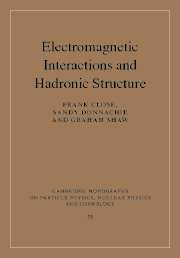Book contents
- Frontmatter
- Contents
- List of contributors
- Preface
- 1 Quark models of hadrons and issues in quark dynamics
- 2 Elastic form factors
- 3 Electromagnetic excitations of nucleon resonances
- 4 Meson radiative decays
- 5 Intermediate-energy photoproduction
- 6 Chiral perturbation theory
- 7 Spin structure functions
- 8 Diffraction and colour dipoles
- 9 Generalized parton distributions
- 10 Quark–hadron duality
- 11 Colour transparency
- Index
11 - Colour transparency
Published online by Cambridge University Press: 15 August 2009
- Frontmatter
- Contents
- List of contributors
- Preface
- 1 Quark models of hadrons and issues in quark dynamics
- 2 Elastic form factors
- 3 Electromagnetic excitations of nucleon resonances
- 4 Meson radiative decays
- 5 Intermediate-energy photoproduction
- 6 Chiral perturbation theory
- 7 Spin structure functions
- 8 Diffraction and colour dipoles
- 9 Generalized parton distributions
- 10 Quark–hadron duality
- 11 Colour transparency
- Index
Summary
The strong interaction between hadrons and nuclei leads to the phenomenon of shadowing. However, in the special situation of high-momentum-transfer coherent processes, these interactions can be turned off, causing the shadowing to disappear and the nucleus to become quantum-mechanically transparent. This phenomenon is known as colour transparency. In more technical language, colour transparency is the vanishing of initial- and final-state interactions, predicted by QCD to occur in high-momentum-transfer quasi-elastic nuclear reactions. These are coherent reactions in which one adds different contributions to obtain the scattering amplitude. Under such conditions the effects of gluons emitted by small colour-singlet systems vanish. Thus colour transparency is also known as colour coherence. The name ‘colour transparency’ is rather unusual. One might think that it concerns transparent objects that have colour, but it is really about how a medium can be transparent to objects without colour. This chapter provides a pedagogic review that defines the phenomenon and the conditions necessary for it to occur, assesses the role of colour transparency in strong interaction physics and reviews experimental and theoretical progress.
Point-like configurations
Strong interactions are strong: when hadrons hit nuclei they generally break up the nucleus or themselves. Indeed, a well-known classical formula states that the intensity of a beam of hadrons falls exponentially with the penetration distance. It is remarkable that QCD admits the possibility that, under certain conditions, the strong interactions can effectively be turned off and hadronic systems can move freely through a nuclear medium.
- Type
- Chapter
- Information
- Electromagnetic Interactions and Hadronic Structure , pp. 457 - 494Publisher: Cambridge University PressPrint publication year: 2007



